Finally you can enjoy soft, flexible gluten-free tortillas with a copycat authentic taste and texture to traditional homemade recipes! These easy tortillas made with gluten-free flour use only 4 simple ingredients and take 30 minutes start to finish. Whether you are a kitchen novice or not, everyone can learn how to make this simple GF tortilla recipe. I’ll show you how!
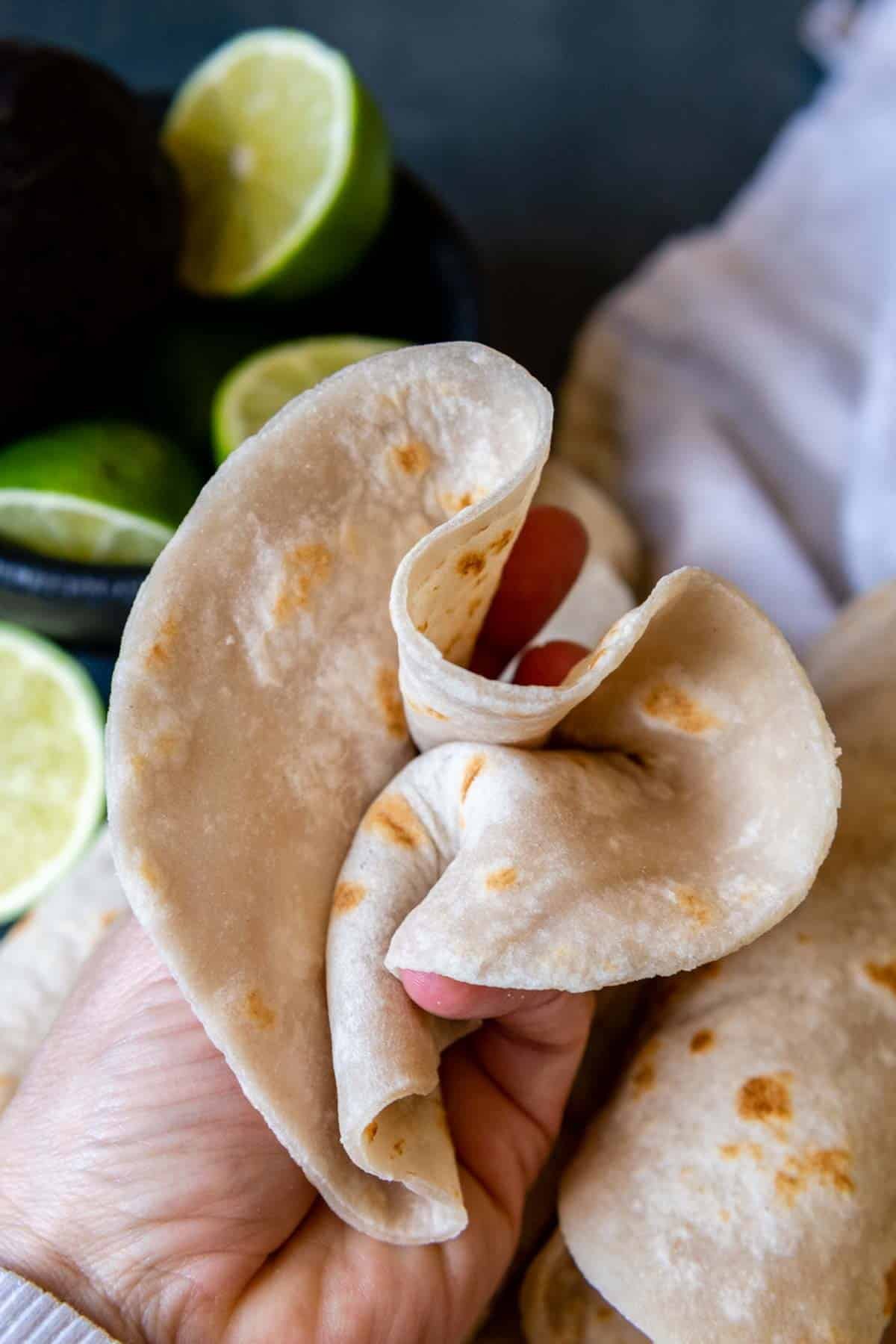
Easy Gluten-free Tortillas
Until I started testing this gluten-free flour tortilla recipe I had given up on ever enjoying them again. I had tried a couple store-bought brands, and if I wasn’t first deterred by the price, the taste and texture made me regret wasting the money.
I said goodbye to gluten-free wraps, quesadillas, burritos, flour shell tacos and more, deciding this was one more thing I was destined to live without (or use another corn tortilla). When I started to perfect more recipes using easy gluten-free baking tips that tasted identical to traditional versions (hello, soft gluten-free flatbread!), I determined all hope was not lost.
It was time to enjoy gluten-fee tortillas again. Every time I enjoy one now I’m mad why I lived without them so long!
So what makes this recipe work? Why do these gluten-free flour tortillas not only have an authentic taste, but such a soft and pliable texture?
While the method and ingredients are simple, it’s their combination that creates such exemplary results. Even if the recipe uses only 4 ingredients, the ingredient ratios’ yields an easy-to-handle dough, not saturated with GF flour, which causes dry and crumbly results.
This is achieved by my favorite, magic gluten-free ingredient, psyllium husk powder. Basically it helps absorb liquid and create elasticity, something GF flour has a hard time doing on its own. You can learn other ways psyllium benefits gluten-free baking in the linked article.
Read on to discover just how easy these GF tortillas are to throw together, as well as many more expert tips to make this recipe a success the first time. It will be love at first bite, guaranteed!
Ingredient Notes
Homemade gluten-free tortillas have a simple list of ingredients, making them dairy-free and vegan as well (see note about GF flour). Below I share any important ingredient notes, as well as any workable substitutions.
- All-purpose gluten-free flour blend – The most important ingredient for taste and structure. I personally love and highly recommend Cup4Cup gluten-free flour because the cornstarch in the mixture gives a nice, flexible texture. Plus, the taste mimics wheat flour without grittiness. See the recommended GF flour section for dairy-free recipe notes and substitutions.
- Psyllium Husk Powder – If you are unfamiliar with this ingredient, don’t be deterred! It’s affordable and used for superior results in everything from flour tortillas to gluten-free breads, like soft GF burger buns or sandwich bread. It helps absorb moisture, making the dough pliable and easy to handle without relying on extra flour (which dries it out). It’s best to buy a blonde or light-colored brand because the darker colors will make the tortillas have a slight purple hue, but doesn’t affect the taste.
- Baking powder – Adding a touch of baking powder gives the tortillas a little lift, making them puff up and bubble similar to traditional ones. While other recipes add more baking powder, I found a smaller amount makes them thinner and more flexible.
- Warm water – Using warm water speeds up the absorption with the flour and psyllium, so the dough does not have to rest a long time before rolling out.
- Oil – Adds softness and texture to the recipe. A little oil helps coat the GF starches, eliminating any grainy, dry texture.
how to make Gluten-free Flour Tortillas
Use the tortillas for wraps, 10-minute crunchwrap gluten-free quesadillas, tacos, Mexican casseroles, such as cheesy gluten-free enchiladas, or as a deep fried taco shell bowl with this gluten-free taco salad!
(Below shows step-by-step photos and modified instructions. For the complete recipe, along with ingredient amounts, scroll down to the recipe card.)
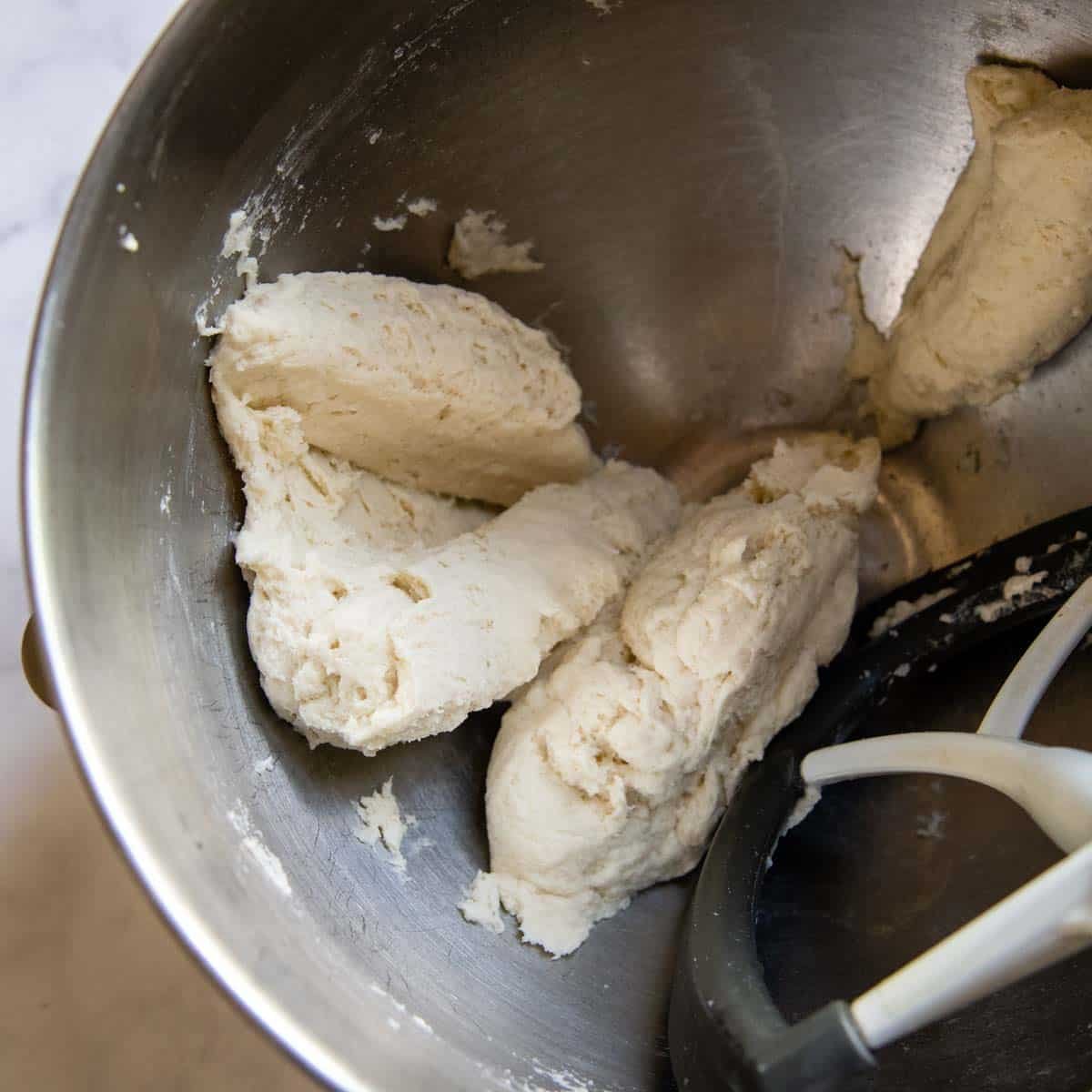
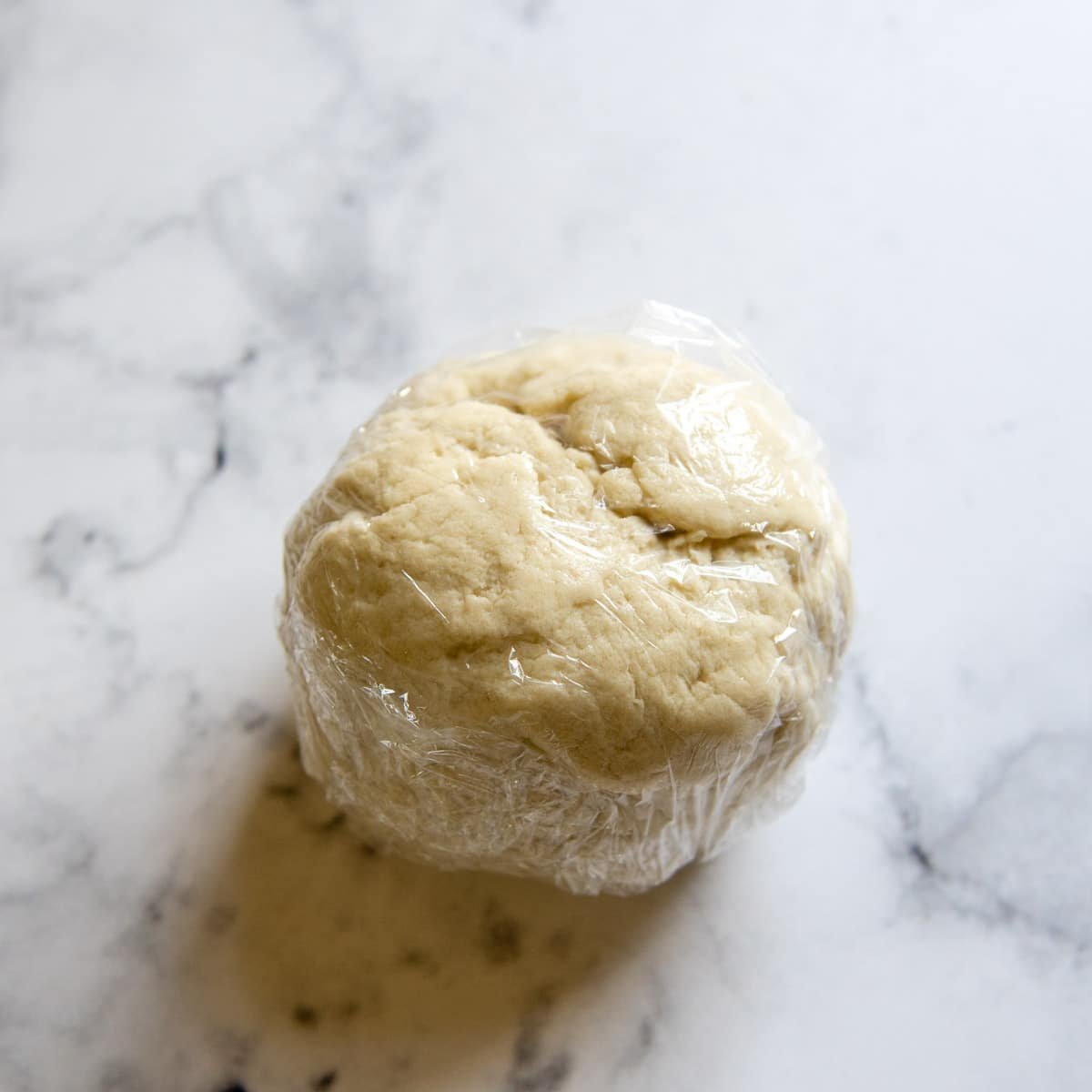
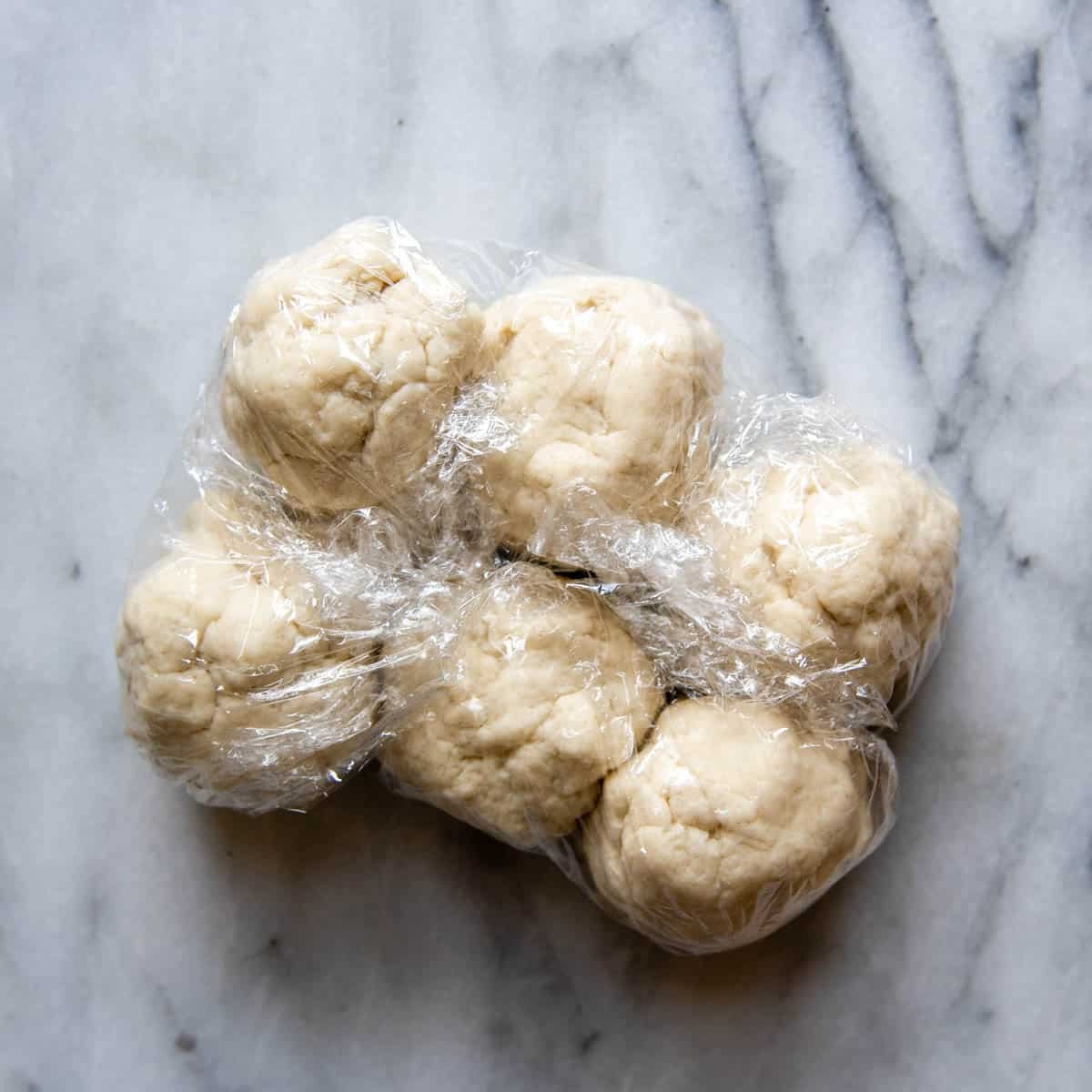
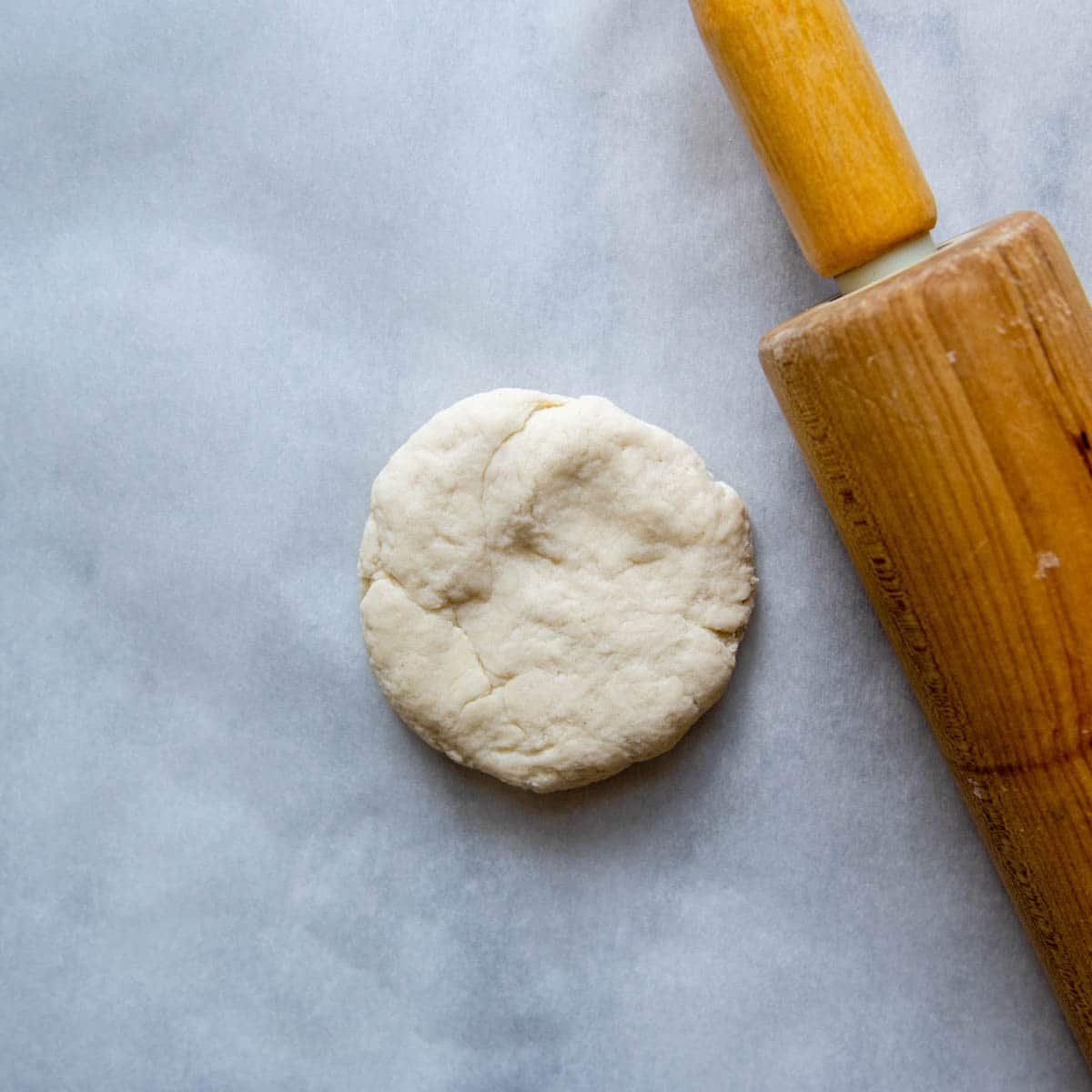
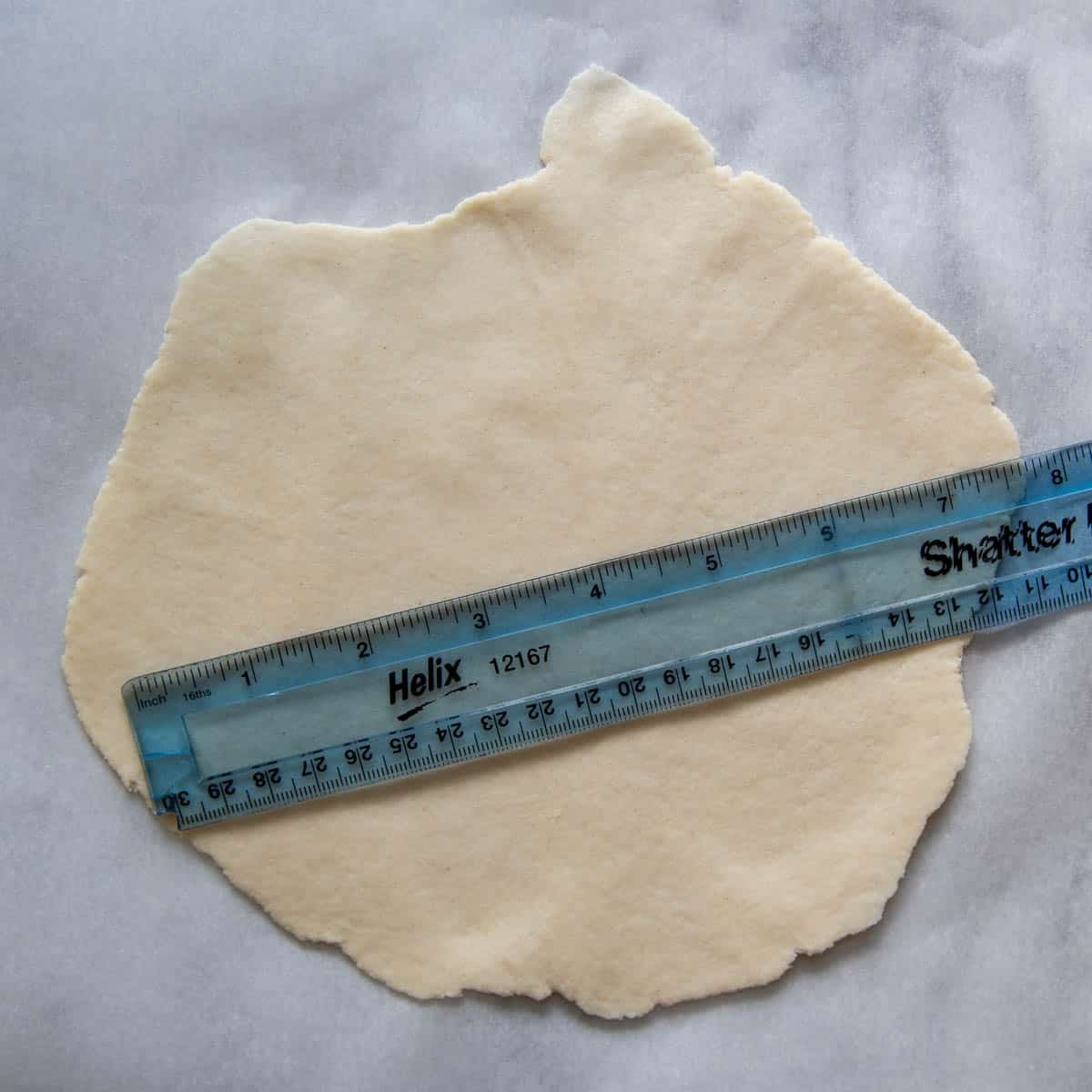
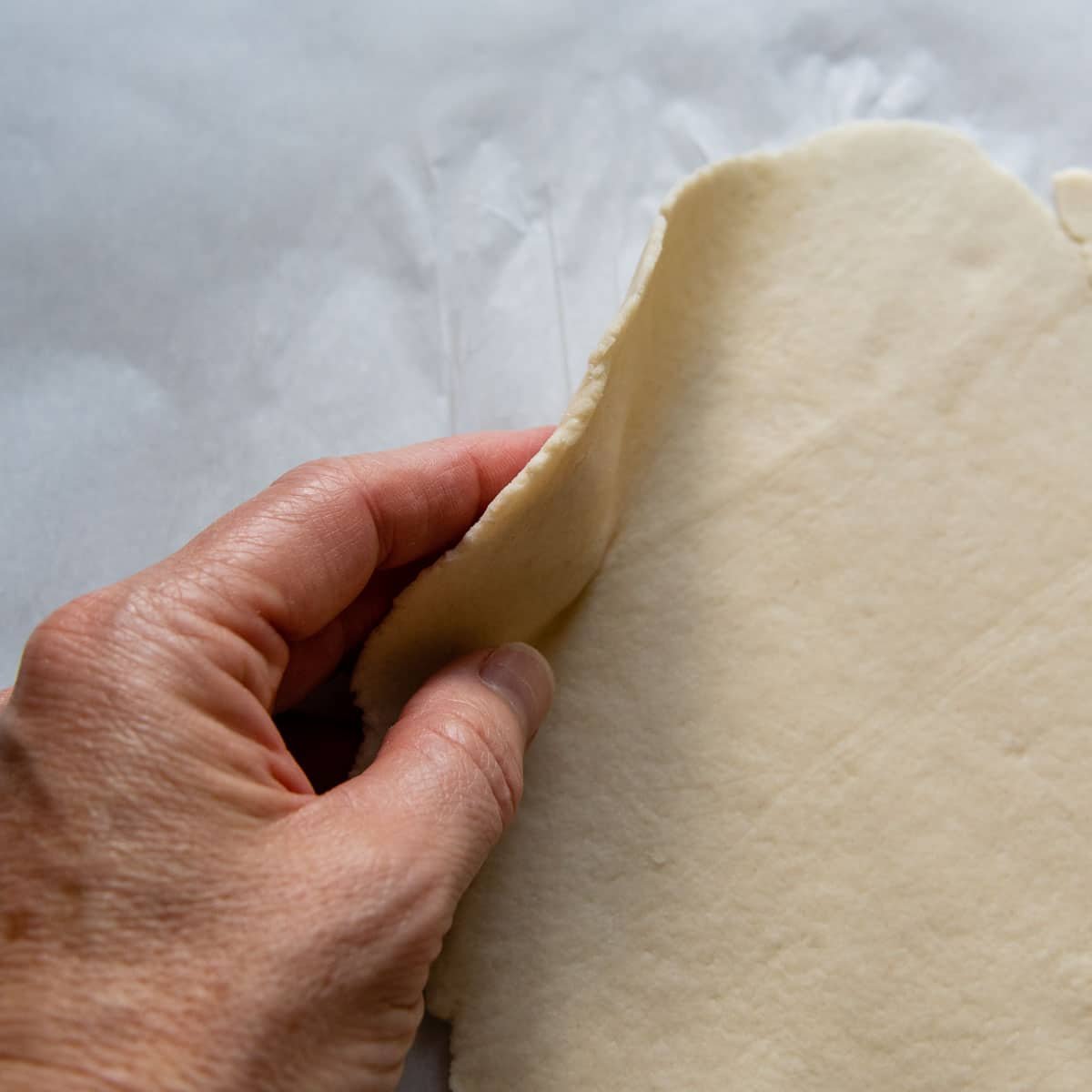
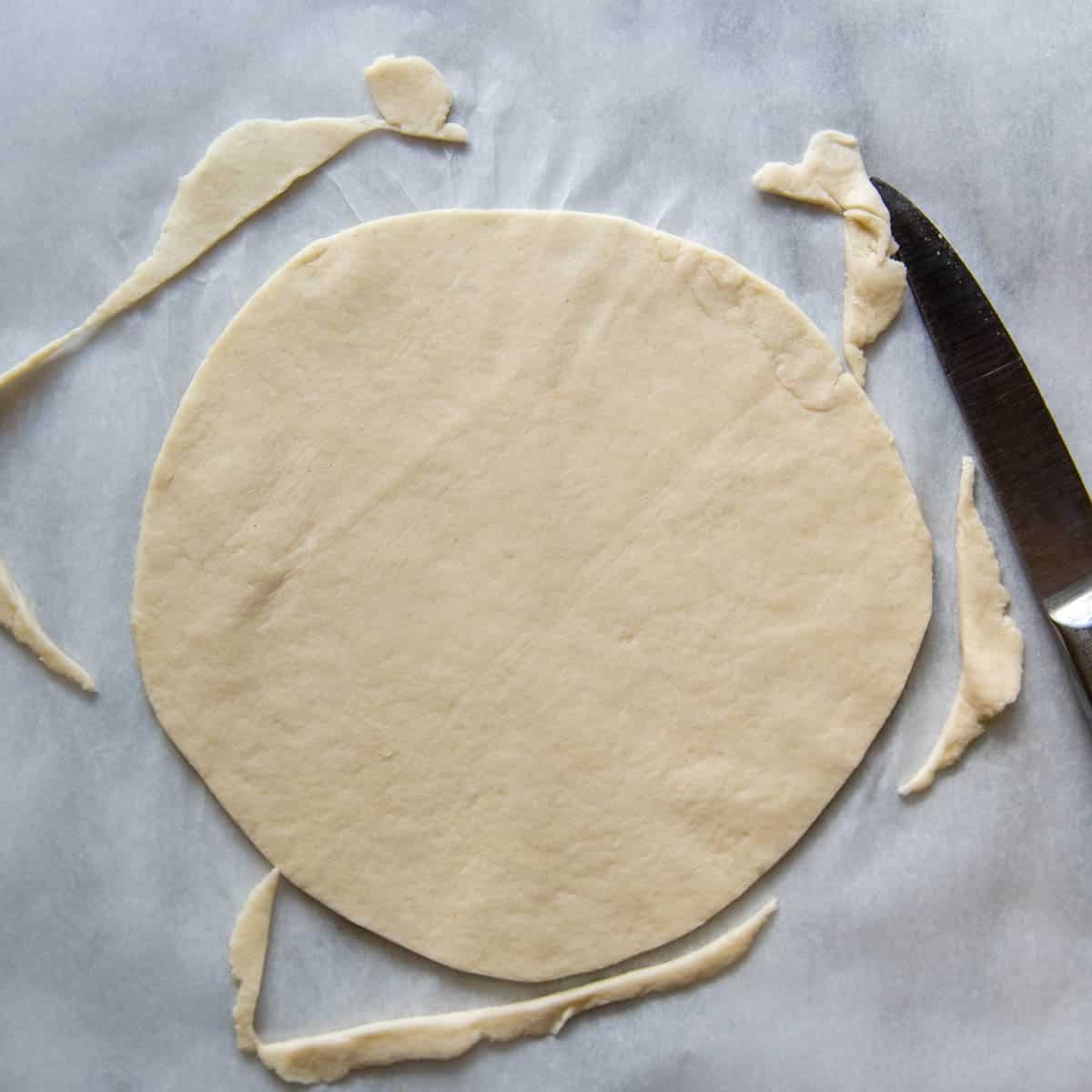
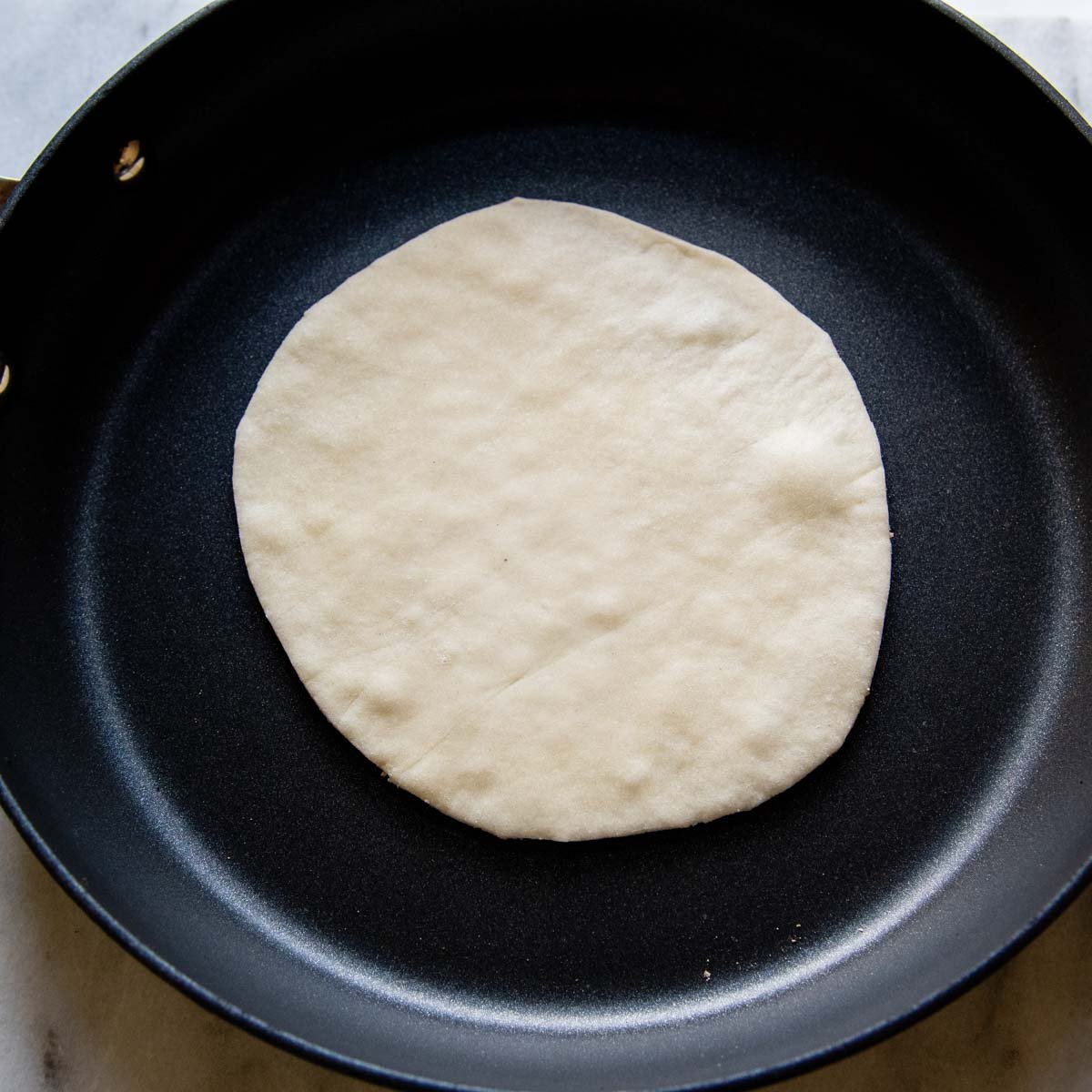
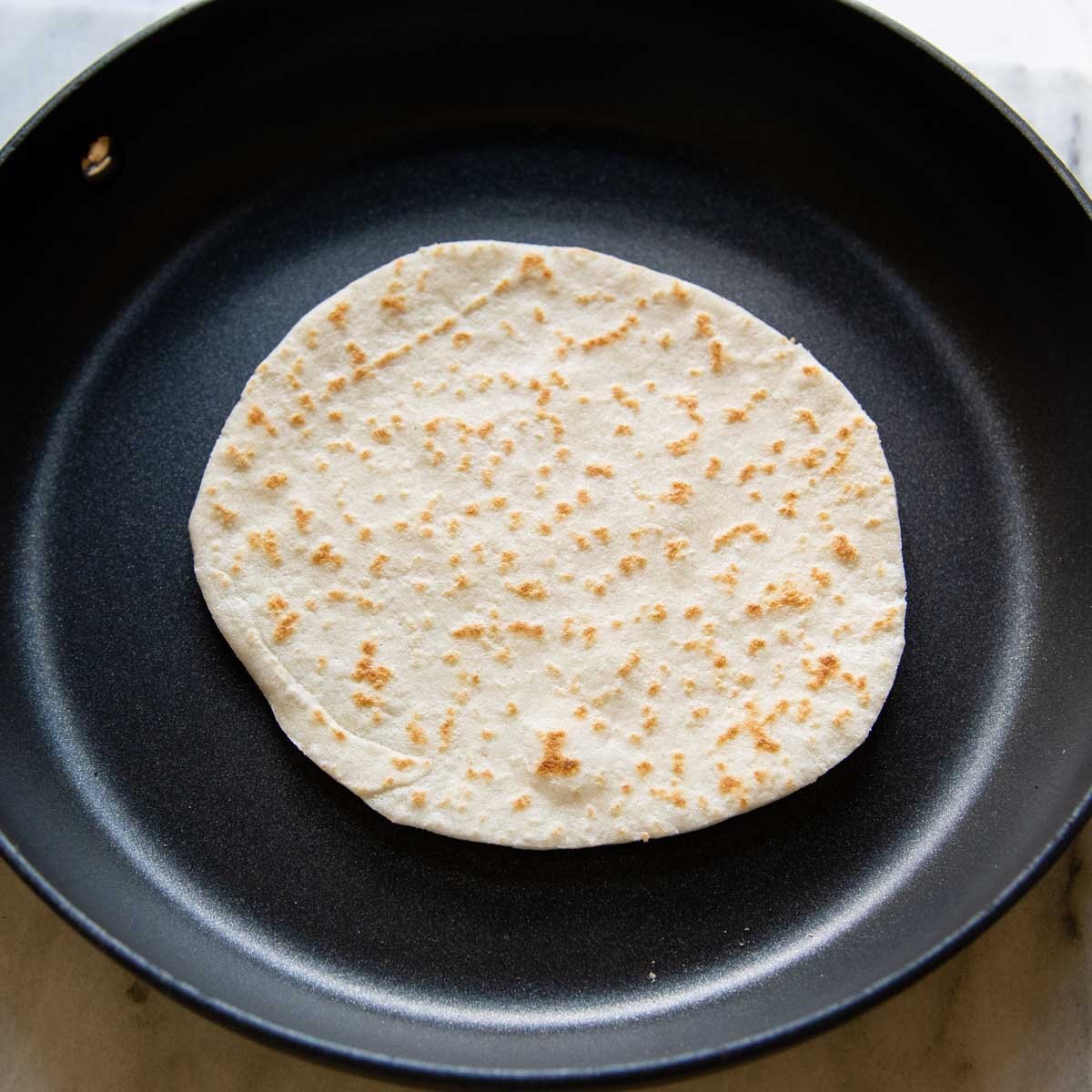
- Use a large bowl and wooden spoon or a stand mixer with a paddle attachment (preferred easy method). On low speed mix together the dry ingredients – gluten-free flour, psyllium husk, baking powder, and salt.
- Continue to mix on low while the warm water and oil are added. Mix until well combined and the dough starts to form a ball, about 1 minute. If you are not using a stand mixer, you may have to knead with your hands at this point so it’s well mixed.
- Shape the dough into a large ball, cover with plastic wrap, and let rest for 10 minutes to hydrate the GF starches and give time for the water to absorb, making the dough easier to work with.
- Divide the dough into 6 equal sized balls. If you want to be really accurate about it, you can use a food scale with a piece of greased plastic wrap on top. Mine weighed 2.7 ounces each, but will vary if using a different GF flour.
- Heat an ungreased nonstick skillet or cast iron skillet over medium-high heat for 5 minutes before cooking the tortillas. While it’s heating begin to roll your first tortilla.
- Flatten the ball into thick disc on a piece of parchment paper. Use a rolling pin to flatten into a 6 1/2-inch diameter circle, rotating quarter turns as you roll. If the dough sticks to the rolling pin, rub a small amount of GF flour on the rolling pin (not the tortilla) and continue to roll.
- Use a knife to go around edges, shaping into a round circle. Save the scraps in a piece of plastic wrap because you can combine them to make an extra tortilla at the end.
- Add the rolled tortilla to the hot pan and cook, undisturbed for 45 seconds, or until the underside has brown spots. Flip it over and cook for 15-20 seconds more. The cook time is key for making sure enough time has passed to cook off moisture and not overcook them, making them stiff.
- If serving immediately, wrap in a lint-free towel or tortilla warmer to keep warm. Otherwise, transfer to a cooling rack. As one tortilla is cooking, begin rolling out the next tortilla to cook.
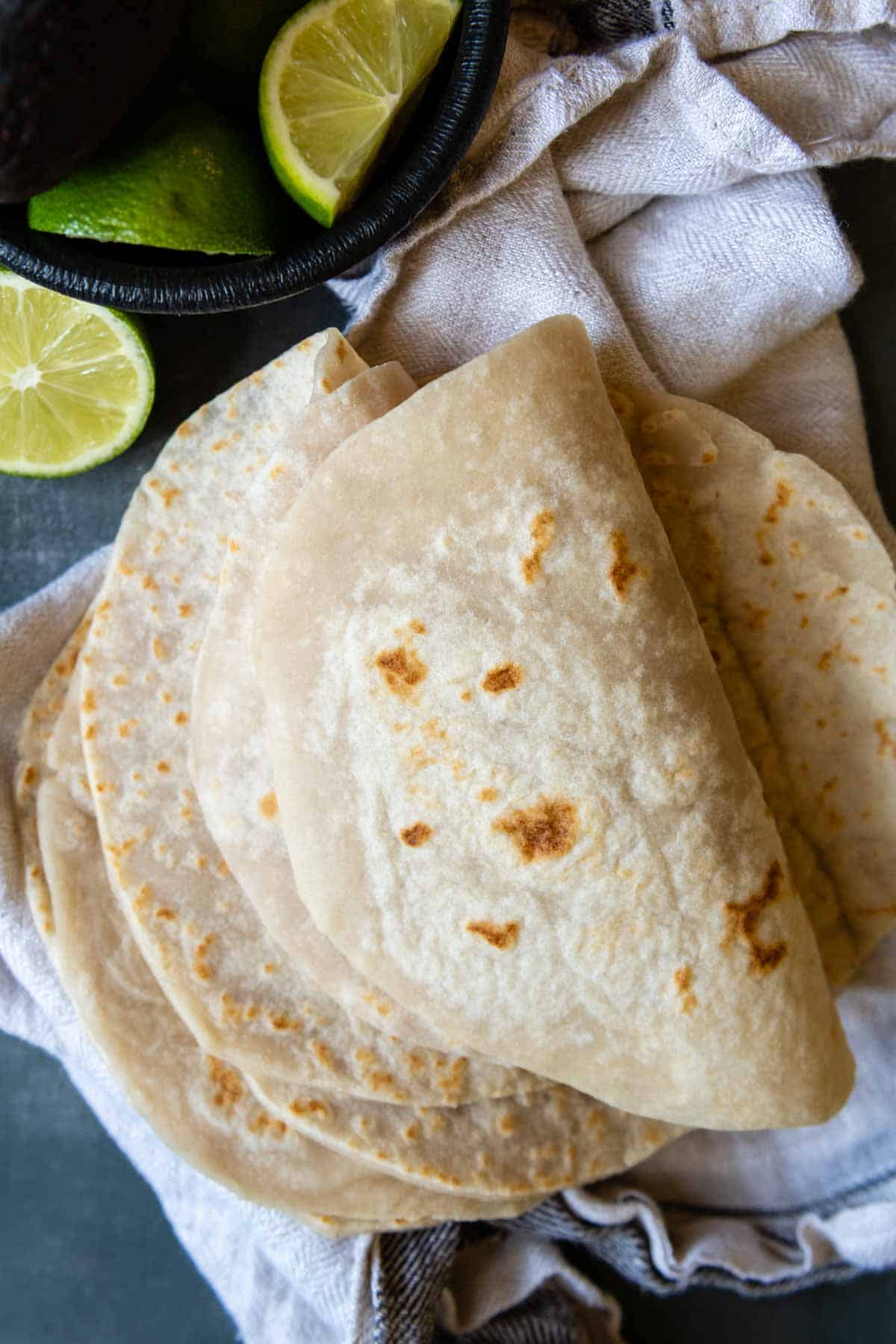
Recommended Gluten-free flour
I use and recommend Cup4Cup gluten-free flour blend for the softest texture and best taste. However, this blend does contain milk powder. For a dairy-free, vegan recipe, use King Arthur Measure-for-Measure. You may want to replace a couple tablespoons of the flour with cornstarch to mimic Cup4Cup.
When making gluten-free recipes, the success primarily relies on the GF flour. Unfortunately, with so many differing varieties and availability it’s hard to test them all with the recipe. They all contain different ratios of starches, which can vary the outcome.
I have tested the most common brands with various recipes, which is why I stand behind Cup4Cup. You can see the results of those blind taste tests on this best gluten-free flour resource.
If you use another GF flour that works well, be sure to leave a note in comments below!
Tips for Handling, Rolling and Shaping
While the dough is easy to work with and handle, here are some easy tips for making the best tortillas, fooling anyone they are gluten-free!
- As you roll, rotate quarter turns to make a round shape. If it begins to become lopsided, simply rip off the bigger side and press wherever dough is needed.
- When you begin to roll, the dough may stick to the rolling pin. Dust a small amount GF flour on the rolling pin, not the tortilla, and roll again.
- If the parchment begins to crease, simply switch out the sheets every couple tortillas.
- You may cut around the edges to make round circles, or refer to this almond flour tortilla recipe to see how you can use a lid or dinner plate to make perfectly round circles.
Do I need a Tortilla Press?
No. It’s easy to make these homemade tortillas without one! See the tips above for rolling and shaping. You only need a rolling pin and knife to make perfectly round circles.
Alternatively, use a tortilla press. Since the dough may stick to the press, you will want to place the dough in a greased gallon ziplock bag. Cut up the sides so it folds open like a book.
Spray the top and bottom and place the dough ball inside. Place that inside the press and close to flatten.
Best Pan to use
Use heavy nonstick pan, one that maintains and distributes heat well, or a cast iron skillet. If using a cast iron skillet, make sure it is well seasoned so the tortillas don’t stick. Either type of pan will be left ungreased.
Storing, Freezing and Reheating
For storage, once they are done cooking and completely cooled, stack between pieces of parchment or paper towels. Transfer to an airtight container or ziplock freezer bag.
Store at room temperature up to one day or in the refrigerator 3 days. They may also be frozen up to 3 months. Stack and wrap securely with plastic wrap before placing in a freezer bag.
When ready to enjoy, briefly microwave for 10 seconds or rewarm in a dry, hot skillet. To make sure they are just as soft as the day you made them, wrap in damp paper towel before reheating or lightly spray the skillet with water before rewarming.
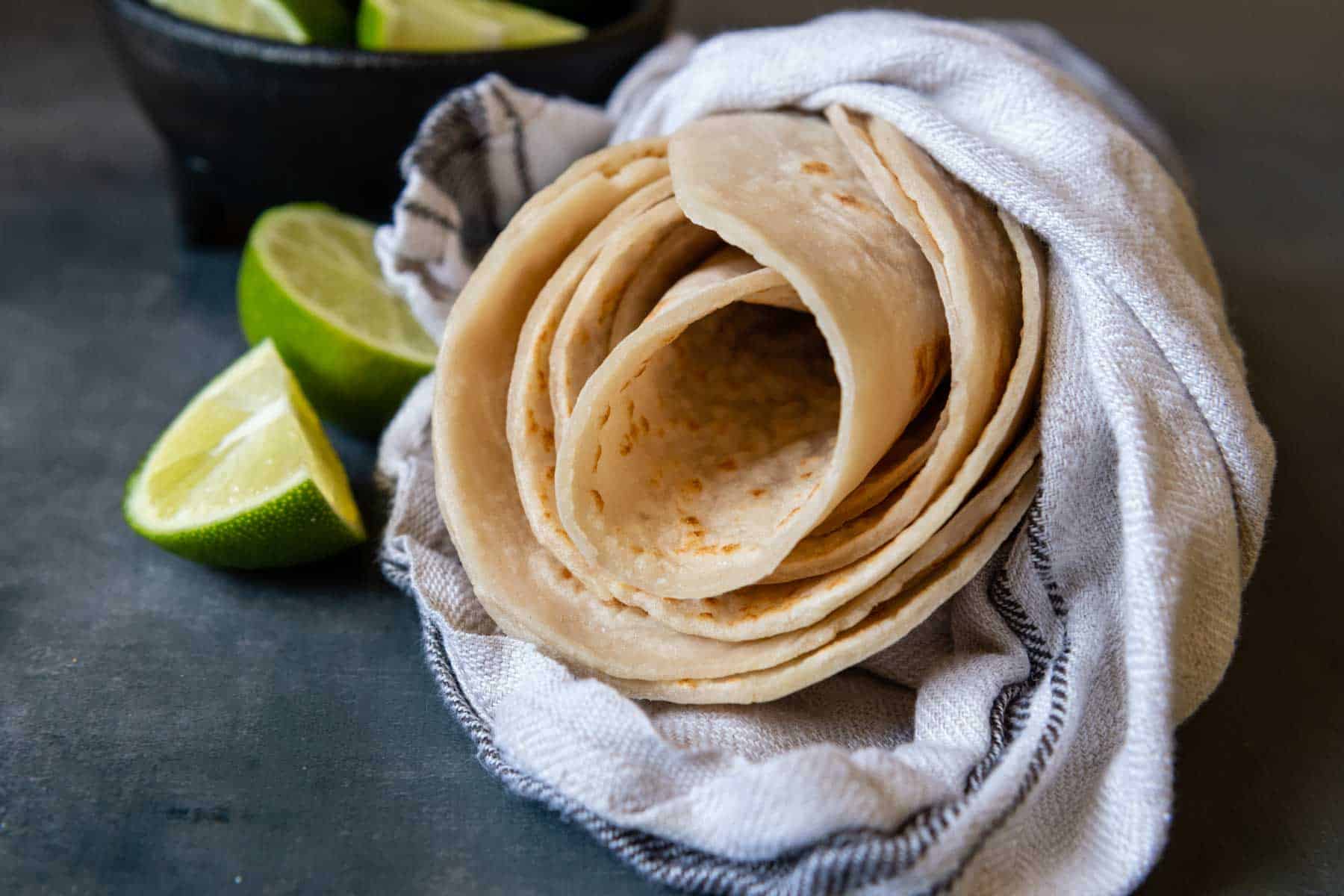
Save this recipe for Gluten-Free Tortillas to your pinterest board!
Let’s be friends on Pinterest! I’m always sharing great recipes!
Soft, Authentic Gluten-Free Flour Tortillas (30 Mins)
Listen to Recipe Audio
Equipment Needed
Ingredients
- 1 ½ cup (214 g) gluten free all purpose flour (Cup4Cup brand highly recommended)
- 2 tablespoons (22 g) psyllium husk powder
- ½ teaspoon salt
- ¼ teaspoon baking powder
- ¾ cup + 2 tablespoons (210 g) very warm water
- 2 tablespoons (27 g) oil canola, vegetable, or olive oil
Instructions
- Use a stand mixer with a paddle attachment (preferred method) or a large bowl and wooden spoon. On low speed mix together the gluten-free flour, psyllium husk, salt. and baking powder.1 ½ cup (214 g) gluten free all purpose flour,2 tablespoons (22 g) psyllium husk powder,½ teaspoon salt,¼ teaspoon baking powder
- Continue to mix on low while the warm water and oil are added. Mix until well combined and the dough starts to form a ball, about 1 minute. If you are not using a stand mixer, you may have to knead with your hands at this point so it's well mixed.¾ cup + 2 tablespoons (210 g) very warm water,2 tablespoons (27 g) oil
- Shape the dough into a large ball, cover with plastic wrap, and let rest for 10 minutes to hydrate the GF starches and give time for the water to absorb, making the dough easier to work with.
- Divide the dough into 6 equal sized balls. Keep covered in plastic wrap while the tortillas are being rolled one at a time.
- Heat an ungreased nonstick skillet over medium-high heat for 5 minutes before cooking the tortillas. While it's heating begin to roll the first tortilla.
- Flatten the ball into thick disc on a piece of parchment paper. Use a rolling pin to flatten into a 6 1/2-inch diameter circle, rotating quarter turns as you roll. If the dough sticks to the rolling pin, rub a small amount of GF flour on the rolling pin (not the tortilla) and continue to roll. (See recipe notes for more rolling tips.)
- Use a knife to go around edges, shaping into a round circle. Save the scraps in a piece of plastic wrap because you can combine them to make an extra tortilla at the end.
- Add the tortilla to the hot pan and cook, undisturbed for 45 seconds, or until the underside has brown spots. Flip it over and cook for 15-20 seconds more. The cook time is key for making sure enough time has passed to cook off moisture and not overcook them, making them stiff.
- If serving immediately, wrap in a lint-free towel or tortilla warmer to keep warm. Otherwise, transfer to a cooling rack. As one tortilla is cooking, begin rolling out the next tortilla to cook.
- Did you make this recipe? Don't forget to click star rating on recipe card and leave a comment below!
Recipe Notes
Note about Dairy-Free
I use and recommend Cup4Cup gluten-free flour blend for the softest texture and best taste. However, this blend does contain milk powder. For a dairy-free, vegan recipe, use King Arthur Measure-for-Measure.Tips for Handling, Rolling, and Shaping
- As you roll, rotate quarter turns to make a round shape. If it begins to become lopsided, simply rip off the bigger side and press wherever dough is needed.
- When you begin to roll, the dough may stick to the rolling pin. Dust a small amount GF flour on the rolling pin, not the tortilla, and roll again.
- If the parchment begins to crease, simply switch out the sheets every couple tortillas.
- You may cut around the edges to make round circles, or refer to this almond flour tortilla recipe to see how you can use a lid or dinner plate to make perfectly round circles.
Storing and Reheating
For storage, once they are done cooking and completely cooled, stack between pieces of parchment or paper towels. Transfer to an airtight container or ziplock freezer bag. Store at room temperature up to one day or in the refrigerator 3 days. They may also be frozen up to 3 months. Stack and wrap securely with plastic wrap before placing in a freezer bag. When ready to enjoy, briefly microwave for 10 seconds or rewarm in a dry, hot skillet. To make sure they are just as soft as the day you made them, wrap in damp paper towel before reheating or lightly spray the skillet with water before rewarming.Nutrition
This post contains affiliate links. My opinions are always my own. If you purchase a product through an affiliate link, I make a small commission – at no cost to you. Read full disclosure policy here.

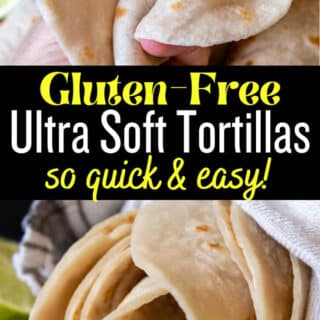
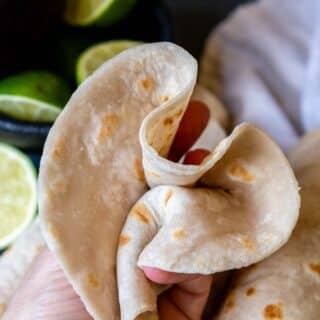
Dennis says
Hi Melissa, thanks for responding! I am using the paddle blade and King Arthur’s Measure For Measure flour. After my first batch, for which I exactly followed the recipe, I also found King Arthur’s texture a bit rougher than expected. For my second batch I added two.more tablespoons of water, thinking that would help the ball formation, which it did and it also helped the texture as well but did not change the thickness at all. I am using a bamboo tortilla press, not a roller. I can exert quite a bit of pressure on it, but still no luck with significantly changing the thickness. I will try your idea of making more, smaller balls to see if that helps. Thanks very much for the suggestions!
Melissa Erdelac says
Thanks for the feedback, Dennis. It’s very helpful. So as far as King Arthur, I typically test recipes with both Cup4Cup and King Arthur because a lot of readers can’t have diary. Across the board, KA is always a little grittier tasting. If you have to use it, I would replace 3-4 tbsp KA flour with cornstarch. That will help with softness. You can judge from there about adding more water since it seemed to have helped you before. As far as the thickness, yes, I didn’t realize you were using a press. That would make them a little thicker. If the smaller size balls don’t help, you might have to hand roll them to get the desired thickness. 🙁 But try the smaller amount of dough first, because a press sounds a lot easier!
Best,
Melissa
Dennis says
Great suggestions, thanks very much Melissa. I’ll need to experiment a bit as we are trying to avoid corn. When I finalize thinner tortillas, I’ll let y’all know!
Dennis says
There’s taste great! I’m so happyi found your recipe! Just one thing, I followed the recipe to the letter. The dough in our mixer never quite forms a ball. it starts to bundle up on the mixer blade, but leaves a lot on the edges of the blade and sides of the bowl. I take the dough out, and form my own ball. I wrap it per the recipe then proceed. However I’ve made two batches and the tortillas have all come out at least twice as thick as I want. Any suggestions?
Melissa Erdelac says
Hi Dennis,
I’d be happy to help. Are you using a paddle attachment in your mixer or whisk blades? If it’s whisk blades, that could be why it’s not forming a ball. As far as the thickness, it could be one of two things. What GF flour are you using? I notice some, like Bob’s Red Mill, has a thicker texture, where King Arthur is thinner (however, I find both this brands a little gritty to the taste). I use Cup4Cup, which contains more cornstarch. You can also try dividing the dough into 7 or 8 balls to begin with so the dough is stretched out thinner as it is rolled. Hope this helps!
Best,
Melissa
Dennis says
Hi Melissa,
Reporting back after a great success! I now have very thin tortillas thanks to your suggestions and some additional detective work on my part. I cut the recipe in half b/c we didn’t need that many tortillas.. I kept all of the ratios the same except I added 3 tablespoons of water to the halved recipe which resulted in a nice ball in my stand mixer! I added 5 minutes to the dough resting period for a total of 15 minutes. I then cut the dough into 8 parts, each of which made a nice, thin 6 inch tortilla using my bamboo press with four 90 degree rotations and re-pressing. PERFECTION! Thank you soooo much for the recipe and suggestions!
Melissa Erdelac says
Yay! So happy to hear, Dennis. Thanks for taking the time to report back!
Best,
Melissa
Sheila says
I know you say a flour with corn starch gives it a better texture, but I can’t have corn. Can you recommend a substitute? Could I buy a gluten free flour and add potato starch to it instead of corn startch?
Melissa Erdelac says
Hi Sheila,
I think that is a great suggestion. I would remove 2-3 tablespoons of the flour blend you are using and replace it with potato starch. Let me know how it turns out!
Best,
Melissa
MLS says
great recipe, easy to roll. Made them bigger – about 8″ to use as a lunch wrap. Also added seasonings of garlic, onion, pepper and paprika and more salt. Came out great!
Melissa Erdelac says
Love these ideas! Thanks for sharing!
Best,
Melissa
Ronda Y says
Wow, all I can say is wow!! I have been struggling to find an easy gluten free flour tortilla recipe that is soft and flexible!! I have ended up with more hard hockey pucks than I care to count!! And then I happened upon Melissa’s phenomenal recipe!! I am seriously blown away!! From the very first one, they came out wonderful!! I did not worry about making them perfectly round, as I didn’t expect them to turn out so well texture and flavor-wise, but next time, as I get more experience, I will strive to make them prettier!! I ended up using a silicone pastry mat, plopped the disc of dough in the center, and covered with a sheet of parchment paper, and rolled away. It worked out really well! The parchment would wrinkle, but I would just lift it up, and carried on, only using one sheet for a double batch of tortillas! They are a little purplish in color, but that does not bother me at all, and I am sure my grandson will think it is cool!! Thank you so VERY much for coming up with these recipes that take the terror out of trying to make gluten free items that taste and feel like the foods that kids and adults are used to!! I can’t wait to try a lot more of your recipes. Well done!! :o)
Melissa Erdelac says
Yay, Ronda! So glad and thank you for adding your tips. The purplish color is from the brand of psyllium. If you purchase the brand linked in the recipe card it will not be purplish. There are so few brands that don’t change the color!
Best,
Melissa
Cynthia Rose Hindsley says
Chewy and delicious. The texture is perfect for really being able to use these different ways and they won’t fall apart.
Melissa Erdelac says
Thank you so much, Cynthia! I’m so happy you love the recipe as much as I do!
Best,
Melissa
Anonymous says
Hello!! I have flax seeds that I can grind up. Can that be used in place of psyllium husk?
Melissa Erdelac says
Hello,
I haven’t tried this. For breads I think it would work but for this recipe in particular I worry about the ground flax seeds creating enough elasticity. Have you tried it with other flatbreads or anything that needs to be rolled?
Best,
Melissa
Shonda Hector says
I’ve never used that much psyllium powder in such a small recipe. Is it really that much?
Melissa Erdelac says
Hi Shonda,
Just so I’m clear, are you asking if 2 TBSP is the correct amount? Yes, I agree it’s more than 1 1/2 cups of flour usually calls for, but tortillas are a different consistency and texture so you need that much to be able to shape, roll, and make them very pliable and flexible after they have cooked (without adding a lot more flour, which would have the opposite effect). Hope this helps!
Best,
Melissa
Will says
Hi.
Can I use regular whole wheat flour?
I’m not gluten intolerant.
Also, I don’t have phyllium husk. Can I use xanthum gum instead?
Thanks
Melissa Erdelac says
Hi Will,
This recipe was created around GF flour. I would recommend an all-purpose flour recipe because I can’t say how it would turn out with the sub. The psyllium is to help bind the GF flour, which wouldn’t be a problem with traditional flour.
Best,
Melissa